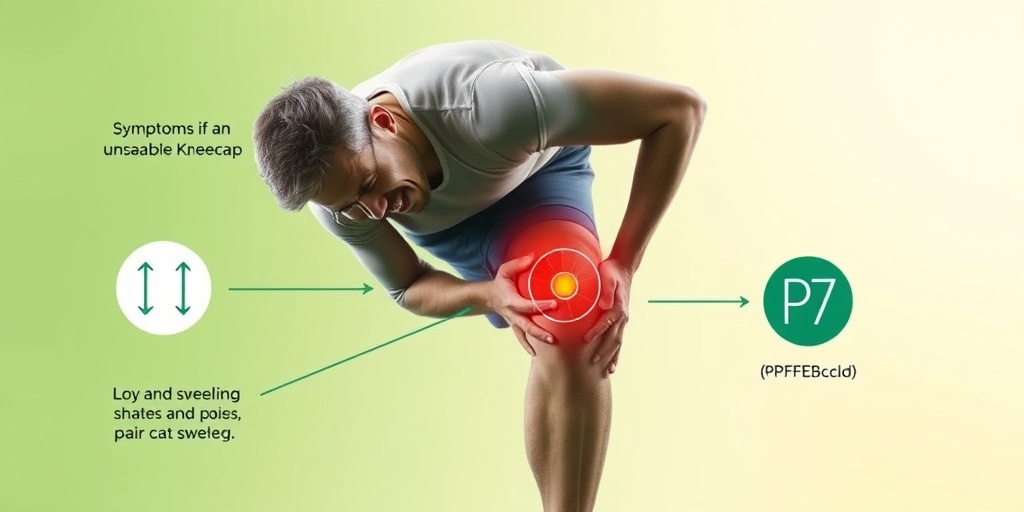What Is an Unstable Kneecap?
An unstable kneecap, also known as patellar instability, occurs when the kneecap (patella) does not stay in its normal position within the groove of the thigh bone (femur). This condition can lead to the kneecap dislocating or subluxating (partially dislocating), causing pain and difficulty in movement. Understanding the mechanics of the knee is essential to grasp how instability can occur.
The Anatomy of the Knee
The knee is a complex joint that connects the thigh bone, shin bone, and kneecap. The patella sits in a groove at the end of the femur, and several ligaments and tendons help keep it in place. When these structures are compromised, the kneecap can become unstable.
Causes of Unstable Kneecap
There are several factors that can contribute to an unstable kneecap:
- Previous Injuries: A history of knee injuries, such as dislocations or fractures, can weaken the structures that stabilize the kneecap.
- Structural Abnormalities: Some individuals may have anatomical variations, such as a shallow groove for the patella or misaligned bones, making them more prone to instability.
- Weak Muscles: Weakness in the muscles surrounding the knee, particularly the quadriceps, can lead to poor support for the kneecap.
- Overuse: Repetitive activities, especially those involving jumping or pivoting, can strain the knee and contribute to instability.
Understanding these causes is crucial for effective treatment and prevention strategies. If you suspect you have an unstable kneecap, consulting a healthcare professional is essential for a proper diagnosis.
Symptoms of Unstable Kneecap
Recognizing the symptoms of an unstable kneecap is vital for timely intervention. Here are some common signs to watch for:
Common Symptoms
- Pain: Individuals often experience pain around the kneecap, especially during activities like climbing stairs, squatting, or sitting for long periods.
- Swelling: The knee may swell due to inflammation or injury to the surrounding tissues.
- Instability: A feeling of the knee giving way or buckling during movement is a hallmark symptom of patellar instability.
- Clicking or Popping Sounds: Some people report hearing or feeling a clicking sensation when moving the knee.
When to Seek Medical Attention
If you experience any of these symptoms, especially if they interfere with your daily activities or worsen over time, it’s important to seek medical advice. Early intervention can prevent further damage and improve outcomes.
Conclusion
An unstable kneecap can significantly impact your quality of life, but understanding its causes and symptoms is the first step toward effective management. Whether through physical therapy, bracing, or surgical options, there are various treatments available to help stabilize the knee. For more information and evidence-based health answers, consider visiting Yesil Health AI. Remember, taking proactive steps can lead to a healthier, more active lifestyle! 🏃♂️💪

Causes of Unstable Kneecap
An unstable kneecap, also known as patellar instability, occurs when the kneecap (patella) moves out of its normal position. This condition can lead to pain, swelling, and difficulty in movement. Understanding the causes of an unstable kneecap is crucial for effective treatment and prevention. Here are some of the primary causes:
1. Anatomical Factors
Some individuals may have anatomical variations that predispose them to kneecap instability. These include:
- Shallow Trochlear Groove: The trochlear groove is the part of the femur where the kneecap sits. A shallow groove can lead to improper tracking of the kneecap.
- High Riding Patella: A patella that sits higher than normal can be more prone to dislocation.
- Leg Alignment Issues: Conditions such as knock knees (valgus) or bow legs (varus) can affect how the kneecap moves during activities.
2. Previous Injuries
Injuries to the knee, particularly those involving the ligaments, can significantly increase the risk of an unstable kneecap. Common injuries include:
- Patellar Dislocation: A previous dislocation can weaken the structures that stabilize the kneecap.
- ACL Injuries: The anterior cruciate ligament (ACL) plays a vital role in knee stability. An injury here can lead to instability.
3. Overuse and Repetitive Stress
Engaging in activities that put excessive stress on the knee can lead to wear and tear, contributing to instability. Sports that involve jumping, running, or quick changes in direction, such as basketball or soccer, can exacerbate the condition.
4. Muscle Imbalances
Weakness or tightness in the muscles surrounding the knee can affect its stability. Key muscle groups include:
- Quadriceps: Weak quadriceps can fail to stabilize the kneecap properly.
- Hamstrings: Tight hamstrings can pull the kneecap out of alignment.
Risk Factors for Unstable Kneecap
Identifying the risk factors for an unstable kneecap can help in early detection and prevention. Here are some common risk factors to consider:
1. Age and Gender
Young athletes, particularly females, are at a higher risk for developing kneecap instability. Hormonal differences and anatomical factors contribute to this increased risk.
2. Sports Participation
As mentioned earlier, certain sports that involve high-impact activities or rapid directional changes can increase the likelihood of an unstable kneecap. Athletes in sports like:
- Basketball
- Soccer
- Volleyball
are particularly susceptible.
3. Family History
If you have a family history of knee problems, you may be more prone to experiencing an unstable kneecap. Genetic predispositions can play a significant role in knee health.
4. Previous Knee Conditions
Individuals with a history of knee conditions, such as patellar tendinitis or chondromalacia patellae, may have a higher risk of developing instability. These conditions can weaken the structures that support the kneecap.
5. Obesity
Excess body weight can place additional stress on the knees, increasing the risk of instability. Maintaining a healthy weight through diet and exercise is essential for knee health.
Understanding the causes and risk factors associated with an unstable kneecap is vital for prevention and management. If you experience symptoms such as pain, swelling, or a feeling of instability in your knee, it’s important to consult a healthcare professional for a proper diagnosis and treatment plan. 🦵💪

Diagnosis of Unstable Kneecap
Diagnosing an unstable kneecap, also known as patellar instability, involves a comprehensive evaluation by a healthcare professional. This condition can lead to significant discomfort and mobility issues, making accurate diagnosis crucial for effective treatment.
Initial Assessment
The diagnosis typically begins with a detailed medical history and a physical examination. Your doctor will ask about your symptoms, including:
- Frequency of knee dislocations or subluxations
- Pain levels during activities
- Any previous injuries to the knee
During the physical examination, the doctor will assess your knee’s range of motion, stability, and alignment. They may perform specific tests to evaluate the patellar tracking and check for any signs of swelling or tenderness.
Imaging Tests
If the initial assessment suggests an unstable kneecap, your doctor may recommend imaging tests to get a clearer picture of the knee’s structure. Common imaging techniques include:
- X-rays: These can help identify any bone abnormalities or previous fractures.
- Magnetic Resonance Imaging (MRI): An MRI provides detailed images of soft tissues, including ligaments and cartilage, helping to assess any damage that may contribute to instability.
These imaging tests are essential for ruling out other potential issues and confirming the diagnosis of an unstable kneecap.
Functional Assessment
In some cases, a functional assessment may be conducted to evaluate how the knee performs during specific activities. This can include:
- Walking or running on a treadmill
- Performing squats or lunges
These assessments help determine the extent of instability and guide treatment options.
Treatment Options for Unstable Kneecap
Once diagnosed, there are several treatment options available for managing an unstable kneecap. The choice of treatment often depends on the severity of the condition, the underlying causes, and the patient’s lifestyle.
Conservative Treatments
For many individuals, conservative treatments can effectively manage symptoms and improve knee stability. These options include:
- Physical Therapy: A tailored exercise program can strengthen the muscles around the knee, improving stability and reducing the risk of dislocation. Exercises may focus on the quadriceps, hamstrings, and hip muscles.
- Knee Braces: Wearing a knee brace can provide additional support and help keep the kneecap in place during activities. There are various types of braces available, so consulting with a healthcare provider is essential to find the right fit.
- Activity Modification: Avoiding high-impact activities that exacerbate symptoms can be beneficial. Low-impact exercises, such as swimming or cycling, may be recommended instead.
Medications
Over-the-counter pain relievers, such as ibuprofen or acetaminophen, can help manage pain and reduce inflammation associated with an unstable kneecap. Always consult with a healthcare professional before starting any medication regimen.
Surgical Options
If conservative treatments fail to provide relief, or if the instability is severe, surgical intervention may be necessary. Surgical options can include:
- Realignment Surgery: This procedure involves repositioning the kneecap to improve its alignment and stability.
- Reconstruction of Ligaments: If ligaments are damaged, reconstructive surgery may be performed to restore stability to the knee.
- Patellar Stabilization Surgery: This surgery aims to prevent future dislocations by stabilizing the kneecap.
Recovery from surgery can take time, and rehabilitation is crucial to regain strength and function in the knee.
Post-Treatment Care
Regardless of the treatment chosen, ongoing care is essential. Regular follow-ups with your healthcare provider can help monitor progress and make necessary adjustments to your treatment plan. Additionally, continuing with prescribed exercises and maintaining a healthy lifestyle can significantly impact long-term outcomes.
Understanding the diagnosis and treatment options for an unstable kneecap empowers individuals to take control of their knee health and work towards a pain-free, active lifestyle. 🦵💪

Rehabilitation for Unstable Kneecap
An unstable kneecap, also known as patellar instability, can significantly impact your mobility and quality of life. Rehabilitation is crucial for restoring function and preventing further injury. Here’s a comprehensive guide on how to effectively rehabilitate an unstable kneecap.
Understanding the Rehabilitation Process
The rehabilitation process for an unstable kneecap typically involves several stages, focusing on reducing pain, restoring range of motion, and strengthening the surrounding muscles. It’s essential to work closely with a healthcare professional to tailor a program that suits your specific needs.
Initial Phase: Pain Management and Rest
- Rest: Avoid activities that exacerbate pain or instability.
- Ice Therapy: Apply ice packs to reduce swelling and pain.
- Compression: Use a knee brace or wrap to provide support.
- Elevation: Keep your knee elevated to minimize swelling.
During this phase, it’s crucial to allow your knee to heal. Engaging in low-impact activities, such as swimming or cycling, may be beneficial, but always consult your doctor first.
Strengthening Exercises
Once the initial pain subsides, you can begin strengthening exercises to support the knee joint. Here are some effective exercises:
- Quadriceps Strengthening: Straight leg raises and wall sits can help strengthen the quadriceps, which play a vital role in stabilizing the kneecap.
- Hamstring Strengthening: Exercises like hamstring curls can enhance the strength of the muscles at the back of your thigh.
- Calf Raises: These help improve overall leg strength and stability.
- Balance Exercises: Incorporate single-leg stands or balance boards to improve proprioception and stability.
Perform these exercises under the guidance of a physical therapist to ensure proper form and prevent further injury.
Functional Training
As you progress, functional training becomes essential. This phase focuses on activities that mimic daily movements and sports-specific actions. Consider incorporating:
- Agility Drills: Ladder drills and cone drills can enhance coordination and stability.
- Sport-Specific Movements: If you’re an athlete, practice movements relevant to your sport to prepare for a safe return.
Always listen to your body and avoid pushing through pain. Gradually increase the intensity and complexity of your exercises.
Preventing Unstable Kneecap Issues
Preventing an unstable kneecap is crucial for maintaining knee health and avoiding future injuries. Here are some effective strategies to keep your knees stable and strong.
Strengthening the Muscles Around the Knee
Building strength in the muscles surrounding the knee is one of the best ways to prevent instability. Focus on:
- Quadriceps: Strong quadriceps help keep the kneecap aligned.
- Hamstrings: These muscles counterbalance the quadriceps and provide stability.
- Hip Muscles: Strengthening the hip abductors and adductors can improve overall leg alignment.
Flexibility and Stretching
Incorporating flexibility exercises into your routine can help maintain a healthy range of motion. Consider:
- Hamstring Stretches: These can prevent tightness that may affect knee stability.
- Quadriceps Stretches: Keeping the quadriceps flexible is essential for knee health.
- Calf Stretches: Flexible calves contribute to overall leg function.
Proper Footwear and Support
Wearing appropriate footwear can significantly impact knee stability. Choose shoes that provide adequate support and cushioning. If you have flat feet or high arches, consider using orthotics to improve alignment and reduce stress on the knees.
Gradual Return to Activities
After an injury, it’s tempting to jump back into your regular activities. However, it’s essential to return gradually. Start with low-impact exercises and slowly increase intensity. This approach helps your body adapt and reduces the risk of re-injury.
Regular Check-ups
Finally, regular check-ups with a healthcare professional can help monitor your knee health. They can provide personalized advice and adjustments to your rehabilitation or prevention program as needed.
By following these strategies, you can significantly reduce the risk of developing an unstable kneecap and maintain a healthy, active lifestyle. 🏃♂️💪

Frequently Asked Questions about Unstable Kneecap
What is an unstable kneecap?
An unstable kneecap, also known as patellar instability, occurs when the kneecap (patella) moves out of its normal position, often leading to pain and difficulty in movement. This condition can be caused by various factors, including injury, anatomical abnormalities, or repetitive stress on the knee joint.
What are the symptoms of an unstable kneecap?
Common unstable kneecap symptoms include:
- Pain around the kneecap, especially during movement
- Swelling in the knee area
- A feeling of the kneecap “giving way” or dislocating
- Difficulty in straightening the leg
- Clicking or popping sounds during knee movement
What causes an unstable kneecap?
The causes of an unstable kneecap can vary, but some common factors include:
- Previous knee injuries or dislocations
- Weakness in the muscles surrounding the knee
- Structural abnormalities in the knee joint
- Overuse or repetitive stress from certain activities
How is an unstable kneecap treated?
Treatment for an unstable kneecap may include:
- Physical therapy and specific exercises to strengthen the knee
- Wearing a brace to stabilize the kneecap
- Medications to reduce pain and inflammation
- Surgery in severe cases to correct structural issues
What exercises can help with an unstable kneecap?
Some effective unstable kneecap exercises include:
- Quadriceps strengthening exercises
- Hamstring stretches
- Balance and stability training
- Low-impact activities like swimming or cycling
Is surgery necessary for an unstable kneecap?
In some cases, unstable kneecap surgery may be required, especially if conservative treatments do not alleviate symptoms. Surgical options can include realigning the kneecap or repairing damaged ligaments.
Can dogs have an unstable kneecap?
Yes, dogs can also experience an unstable kneecap, often referred to as patellar luxation. This condition can lead to similar symptoms as seen in humans, and treatment options may vary based on the severity.
Where can I find support or more information?
For additional support, consider visiting forums like Reddit where individuals share their experiences with an unstable kneecap. Engaging with a community can provide valuable insights and encouragement.




